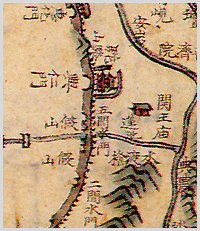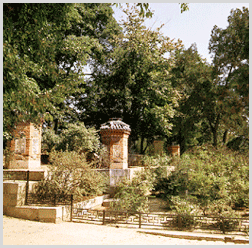|
|
 Gasan (Unreal Mountain) Gasan (Unreal Mountain)
|
|
|
| Literally meaning either “false” or “unreal mountain,” gasan was an important
element of the traditional Korean garden conceived by connoisseurs who wanted to condense a large natural landscape into their
garden. The “mountain” was sometimes made with earth dug to make an artificial lake or pond in a royal palace. We can see an
example of this in the work by Amisan of Gyotaejeon (Hall) and the tiny island on the lake of Gyeonghoeru (Pavilion) in
Gyeongbokgung (Palace). Gasan was also developed in an effort to increase the life energy (“gi”) of a site according to pungsu
(or feng sui) principles. The founders of the Joseon dynasty, for instance, created an artificial mountain within the
precincts of the Royal Shrine of Jongmyo in an effort to supplement the weak land energy in front of the shrine. |
|

|
Records show that there were two “man-made mountains” around Ogansumun, one in the south and the other in the north
of the Cheonggyecheon waterway. The mountains were made during the 1760 dredging work with earth and sands dredged
from the Cheonggyecheon. When the dredging started, Cheonggyecheon had been filled up with drifts that raised the
riverbed almost to the same height of the embankments built on both sides of the waterway. Dredging was not an easy
task, of course, but a more difficult question was how to deal with the huge amounts of dredged earth and sand.
Without efficient means to remove the silt, they relied on any expedient means that could be found. One idea was to
fill in sunken roads and low-lying land around the area but most was left heaped up wherever there was space.
As the project neared completion in April, King Yeongjo requested a report about the dredging work from a
senior minister named Yu Cheok-
|
|
|
gi (1691-1767). In the report, Yu said that the dredged silt should be removed to a distant place even if that meant
spending a lot of money. The king accepted his advice, and the result was the creation of two huge mounds erected outside
both banks on both sides of Ogansumun. Most old maps published after 1770 clearly show the two large mounds at both sides
of Ogansumn with names gasan (“false mountain”) or josan (“artificial mountain”).
|
These mounds were in fact nothing but loosely piled silt, which continued to grow with each dredging project that followed.
Then the hills began to collapse, finally turning themselves into gently sloped hills where people came to plant tress and
flowers. When the authority gave new names to the districts of Seoul in 1914, the area was named as Bangsan-dong (“district
of floral mountains”) because of the sweet fragrance of flowers filling the air around the mounds.
|
| With The increased population of Seoul combined with the currents of modernization
the historic heritage of gasan gradually vanished. The gasan in the north was heavily damaged in 1898 where a tramcar
house was built on the site. The other in the south was damaged when the Joseon School of Medicine was built in 1918
and then the Gyeongseong Teachers College in 1921. Earth from the mounds was used for the renovation of roads in the
Jongno area. Today, the site of the southern gasan is occupied by Pyeonghwa Market in Cheonggyecheon 6-ga and the
National Medical Center in Bangsan-dong while the site of the northern gasan by the Dongdaemun Shopping District. |
|

|
|
| |
|
|
|
|
|
|






